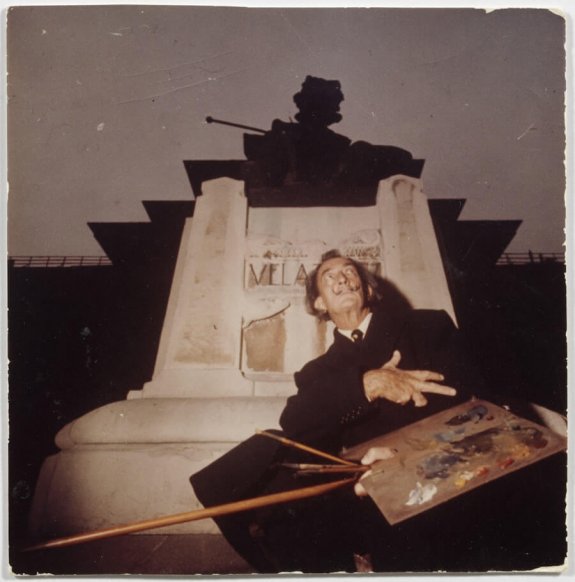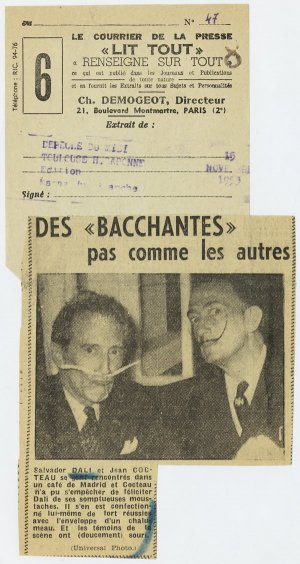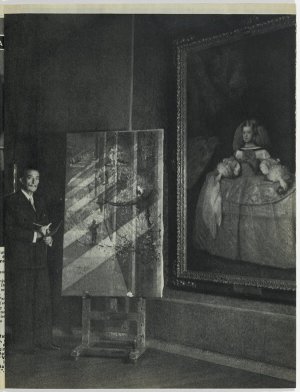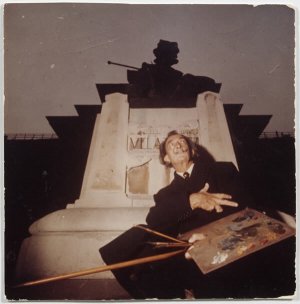
Lucia Moni – Centre for Dalinian Studies, Fundació Gala-Salvador Dalí
Salvador Dalí's relationship with the Museo del Prado extended throughout the artist's life. Defined by Dalí as 'incontestably the best museum of old paintings in the world', the Madrid museum and the works in its collection by Raphael, Hieronymus Bosch and Velázquez, among others, were to become recurring references in Dalí's art.
During a visit to the Prado in 1922, Velázquez's paintings made the 'strongest impression' on Dalí. More than half a century later, Dalí closed the circle with the lecture he gave in the Sala Velázquez of the same museum in 1973. The young apprentice painter was now a consecrated artist.
Chronology
1922
In September, Dalí went to Madrid to sit the entrance examination for the Special School of Painting, Sculpture and Engraving of the Real Academia de Bellas Artes de San Fernando in Madrid. While waiting for the result, and confident that he would be accepted, Dalí wrote to his uncle Anselm Domènech (a bookseller in Barcelona who helped him in his first steps as an artist) to tell him about his first experiences in the capital. Dalí was enthusiastic about the city, and particularly remarked that the 'strongest impression' had been made on him by Velázquez's paintings in the Prado Museum.[1]
1922-1926
Dalí, a young student in search of his own style, with a keen interest in the avant-garde, nurtured his passion for art with visits to the Prado. He complemented his classes at the Real Academia de Bellas Artes with in situ study of the painting of the great masters on Sunday mornings: 'This was the start of a monk-like period for me, devoted entirely to solitary work: visits to the Prado, where, pencil in hand, I analyzed all of the great masterpieces, studio work, models, research.'[2]
As the poet and painter José Moreno Villa, who, like Dalí, also lodged in the Residencia de Estudiantes, recalls in his 1976 autobiography Vida en claro: 'Together with Federico [García Lorca] I remember Salvador Dalí, who was entirely the opposite. Very thin, almost silent, enclosed in himself, shy (who would have said so?), like a child left alone for the first time or violently separated from his father and his sister; long-haired, not very clean, always absorbed in his reading of Freud and the modern theorists of painting. His vocation was indisputable. In a short time he mastered the craft, rebelled against the atmosphere of the Academy of San Fernando and painted some little pictures that I took one afternoon to the Prado so that the students who came with me could compare their meticulous execution with that of the Flemish Primitives.'[3]
1940
Following the German occupation of Paris and the arrival of German troops in Bordeaux, in June the Dalís left Arcachon, in south-western France, where they had taken refuge when war was declared. Gala went to Lisbon to arrange their passage to the United States, while Dalí made a detour to Figueres and Cadaqués to visit his father and sister. From there he went to Madrid, where he stayed for a few days before going on to Lisbon to be reunited with Gala and sail with her to New York.
In Madrid in July, before leaving for the United States, where the couple were to live for the next eight years, Dalí felt the need to visit the Museo del Prado. The weekly Destino reported that during his short stay in Madrid the painter had claimed 'to be determined to rectify the orientation and mode of his painting.'[4] And he was to do just that. Dalí's arrival in the United States marked the beginning of a new stage in his life, a rebirth that coincided with the writing of his autobiography The Secret Life of Salvador Dalí. The artist declared his intention in the catalogue of the exhibition at the Julien Levy Gallery in 1941: 'TO BECOME CLASSIC! [...] Now or never!'[5]
1947
In the second and final issue of Dali News, the newspaper created by the artist for the exclusive purpose of promoting himself and his work, he expressed the belief that: 'The best museum in the world is the Museum of the Prado, in Madrid.'[6]
1948
In Madrid in December, Dalí paid a visit to the Prado, accompanied by Gala and his cousin Gonzalo Serraclara. The little party also included the journalist Félix Ros, who documented the visit of an hour and a half, in the course of which Dalí commented on a number of works, one of which was the The Garden of Earthly Delights by Hieronymus Bosch: Dalí explained that he had offered a copyist 50 pesetas to make him a copy of this painting, which had always fascinated him and served as a model and inspiration for his own art. Mantegna's Death of the Virgin, with which Dalí said his friend Federico García Lorca had been obsessed, also attracted his attention. Stopping in front of Raphael's The Holy Family with a Lamb, Dalí expressed his admiration by repeating 'Brilliant, brilliant, brilliant',[7]and in front of another Raphael, Portrait of a Cardinal, he declared it to be the best ecclesiastical portrait that had ever been painted.[8]
In addition to giving his opinion on these masterpieces, during the tour the artist also explained significant details of pictures that had inspired him in his own work. For instance, he revealed that the empty space in the centre of Velázquez's Las lanzas or The Surrender of Breda in which the key of the city is being handed over is replicated in his painting The Eviction of Furniture-Nutrition,[9] in the form of the rectangular opening in the back of the wet-nurse.
1950
Dalí wrote an article for American Vogue entitled 'To Spain, Guided by Dalí', in which he takes the reader on a tour of the historical, artistic and gastronomic heritage of the principal Spanish cities and towns. The Prado is presented here as 'incontestably the best museum of old paintings in the world' and, among its treasures, two of Raphael's works are mentioned as 'the pictures preferred by Dali'.[10] In the same article Dalí claims that the best guidebook to the museum was written by an aesthetician, Eugenio d'Ors, and is called 'Three Hours in the Museum of the Prado' or Tres horas en el Museo del Prado.
1951
On November 11, at an event in the Teatro María Guerrero in Madrid hosted by the Instituto de Cultura Hispánica, Salvador Dalí gave a lecture entitled 'Picasso y yo' ['Picasso and I'], which aroused considerable expectation. On the day before the talk, Dalí received journalists in the office of the director of the Exposición Bienal Hispanoamericana de Arte; also present were the secretary of the Biennial and the press officer of the Instituto de Cultura Hispánica. The journalists centred their questions on the talk that the painter was to give the next day, but Dalí took the opportunity to speak about other subjects, such as the importance of a return to the Renaissance tradition. Dalí was quoted as saying that 'to be president of the Board of the Museo del Prado would be an honour for him, but it does not enter into his activities',[11] and in another article is reported to have said that 'it would be a great honour for him to be director of the Museo del Prado, but for now his activities are going in other directions'.[12]
1953
Salvador Dalí took Jean Cocteau on a tour of the Museo del Prado during one of the French poet and filmmaker's trips to Spain in 1953.[13] Cocteau visited the Prado in July of that year,[14] and he and Dalí probably went round it together in November. Both were frequent visitors to the Madrid museum. In his article 'Conversaciones con Jean Cocteau', published in the magazine Revista that same November, César González-Ruano explained that Cocteau had a passion for the Prado, and went there every morning during his stay in Madrid: 'It is not a museum, it is a boulevard,' he quotes Cocteau as saying.15] In another article in the same magazine Cocteau says: 'In the Prado, the women who visit it, the paintings, everything is alive and lively. The Louvre is a museum; the Prado is a house, a mansion inhabited by geniuses.' [16]
The same November issue of the magazine Revista included Dalí's comments on what had brought him to the capital: 'I have come to Madrid due to the urgent need to contemplate Las Meninas. Velázquez obsesses me.'[17]
At the end of their joint visit the two artists gave a press conference. Many years later, in 1977, Dalí recounted a number of anecdotes from that day in an interview with Joaquín Soler Serrano on the Spanish television programme A fondo. (19' 20'' - 21' 10'')
The exchange below is from the television interview:
Joaquín Soler Serrano: Was your adventure more violent?
Salvador Dalí: Violent and classic, because I am always eccentric and concentric. The most classic was the day we went to look at the Museo del Prado with Jean Cocteau, who had the most refined French spirit, and when we left there was a press conference, and one journalist confronted him with the old question: 'If the Prado had been burning down, what would you have taken?' I imagined what he was going to say, which was a Greek plagiarism. He said: 'I should have taken the fire.' Then the journalists turned to me: 'And you, what would you have taken?' I got theatrical, I pretended to reflect, and I said: 'Dalí would take the air, nothing less than the air, and specifically the air contained in Velázquez's Las Meninas, which is the air of the finest quality that exists.' And naturally, since fire is not a paintable element, and the air is the protagonist of the painting, Cocteau himself took two cocktail straws and placed them in the form of a moustache, bowing his head before the divine Dalí.[18]

1958
On or around November 16, 1958, Salvador Dalí visited the Prado Museum with Miguel Utrillo and Gala.[19]
In January 1959, the weekly Blanco y Negro carried a report by Miguel Utrillo in which he described their stay in Madrid and their visit to the Prado. On the subject of this visit, Dalí declared: 'I have urgencies of an almost physiological kind to see the Museo del Prado and the great Velázquez. [...] I want to finish a copy of the picture of the Infanta Margarita, by Velázquez, which I have in a very advanced state. This very moment we are going to see Don Fernando Álvarez de Sotomayor, my old and much admired friend.'[20]During this visit to the director of the Prado, Dalí asked to be allowed to put the finishing touches to a copy of the painting of the Infanta at a time when the public was not admitted to the museum. Having positioned himself in front of the Velázquez picture, Dalí proceeded to put the finishing touches to his Velázquez Painting the Infanta Margarita with the Lights and Shadows of His Proper Glory.[21]

1962
Francisco Javier Sánchez Cantón, director of the Museo del Prado from 1960 to 1968, wrote the foreword to the 1962 book Dalí de Gala, in which he celebrated Dalí's exceptional knowledge of Renaissance art and the extent of the Renaissance influence on his work.[22] According to Dalí, Sánchez Cantón 'has been able to interpret not how people imagine I must be, but as I really am. And this, be it said without modesty, makes me proud. And for the record, I have exchanged barely two words with him. And that too has its importance.'[23]
1973
On May 29, Dalí delivered the lecture 'Velázquez y yo' ['Velázquez and I'] in the Sala Velázquez of the Museo del Prado. The artist took the occasion to present his Equestrian Portrait of Carmen Martínez-Bordiú.[24].
The spectacle had been prepared down to the last detail: a member of the museum staff brought a palette and paintbrush to the Master, who invited Martínez-Bordiú, the Duchess of Cádiz, to take a seat next to the painting, and (symbolically) completed the picture 'in the flesh' by applying a final touch of paint to the face of the Duchess herself.
The press of the day made much of the exceptional nature of this event. Some papers even claimed it was the first time the Prado had ever hosted a lecture,[25] and certainly this unusual show was without parallel in the museum's history. The lecture-cum-spectacle was attended by a very select audience, including many public figures, at the invitation of the Chairman of the Board of the Museo del Prado and the Minister of Education and Science, José Luis Villar Palasí, and was organized by the Directorate General of Fine Arts.[26]
At the end of the lecture, when Dalí was asked whether the museum's galleries should be used for any purpose other than the display of artworks, he declared: 'Undoubtedly, if they do not wish to be left as dead houses. And I want an example of what I am saying to be my museum in Figueres, where several rooms will be reserved for the living art of the moment and for cultural events. In my museum the colloquium of the artists with the public will be an essential number.' [27]
The artist went on to propose that painters have the opportunity to express their ideas at events organized in museums: '"Mr Dalí! Should your talk at the Museo del Prado be interpreted as an attempt, as a first step, for the other Spanish painters to follow you and also expound their artistic views here? Do you think that museums can be used for this?" "My friend," Salvador Dalí replied, "of course I agree, and if it were up to me, all the painters would have the rooms open to them to speak ... yes, I support this ab-so-lu-te-ly, you may say."'[28]

-
Letter from Salvador Dalí to Anselm Domènech, published in Salvador Dalí, lletres i ninots: fons Dalí del Museu Abelló, Museu Abelló, Fundació Municipal d'Art, Mollet del Vallès, 2001, p. 124-125 (our translation).
-
Salvador Dalí, André Parinaud, The Unspeakable Confessions of Salvador Dali, William Morrow, New York, 1976, p. 52.
-
José Moreno Villa, Vida en claro, autobiografía, Fondo de Cultura Económica, Mexico City, Madrid, Buenos Aires, 1976, p. 111 (our translation).
-
'Secreto a voces', Destino, Barcelona, 24/08/1940 (our translation).
-
Salvador Dalí, The Last Scandal of Salvador Dali, exhibition catalogue, Julien Levy Gallery, New York, 1941.
-
Salvador Dalí, Dali News, New York, 25/11/1947, p. 2.
-
Félix Ros, '¡Dalí visita el Museo del Prado!', La Tarde, Madrid, 14/12/1948 (our translation).
-
Félix Ros, 'Dalí en el Prado', Mundo Hispánico, Madrid, February 1949 (our translation).
-
Catalogue Raisonné of Paintings by Salvador Dalí, No. 372
-
Salvador Dalí, 'To Spain, Guided by Dalí', Vogue, Greenwich (CT), 15/05/1950, p. 94.
-
'Dalí es partidario de la vuelta al Renacimiento', El Alcázar, Madrid, 10/11/1951 (our translation).
-
'Salvador Dalí dice: "la pintura española es la mejor del mundo"', Pueblo, Madrid, 10/11/1951 (our translation).
-
French poet, writer, dramatist, designer and filmmaker. For more information, see Montse Aguer Teixidor, Fèlix Fanés, Salvador Dalí. Álbum de familia, Fundació Gala-Salvador Dalí, Fundació "La Caixa", Figueres, Barcelona, 1998, p. 25.
-
'Una nota para el archivo, los días madrileños de Jean Cocteau', ABC, Madrid, 30/07/1953.
-
César González-Ruano, 'Conversaciones con Jean Cocteau', Revista, 19-25/11/1953, p. 6 (our translation).
-
Ángel del Campo, 'Jean Cocteau', Revista, 19-25/11/1953, p. 1 (our translation).
-
Ibídem, p. 13.
-
Joaquín Soler Serrano, Personajes a fondo, Planeta, Barcelona, 1987, p. 269 (our translation).
-
Antonio D. Olano, 'Aquí tenemos a Dalí', Los Sitios, Girona, 16/11/1958.
-
Miguel Utrillo, 'Dalí en zig-zag', Blanco y Negro, Madrid, 10/01/1959 (our translation).
-
Catalogue Raisonné of Paintings by Salvador Dalí, No. 735.
-
Robert Descharnes, Dalí de Gala, Edita, Lausanne, 1962.
-
Miguel Utrillo, 'En casa de Salvador Dalí', Blanco y Negro, Madrid, 15/09/1962 (our translation).
-
Catalogue Raisonné of Paintings by Salvador Dalí, No. 868.
-
'Oráculo de Dalí en el Prado', El Ideal Gallego, La Coruña, 30/05/1973.
-
'Próxima conferencia de Dalí en el Museo del Prado', Faro de Vigo, Vigo, 23/05/1973.
-
Ramon Calanda, "Salvador Dalí, en improvisada rueda de prensa", Las Provincias, Valencia, 30/05/1973 (our translation).
-
Ignacio Carrión, 'Dalí en el museo del Prado: Velázquez y yo', Blanco y Negro, Madrid, 09/06/1973 (our translation).


